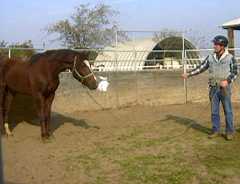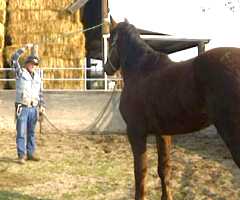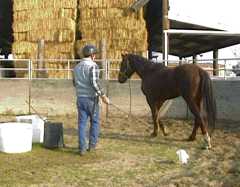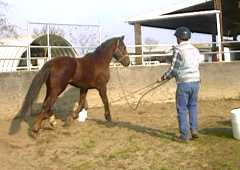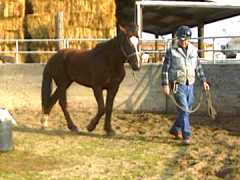KBR Horse Net
|
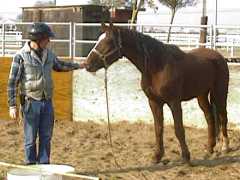
|
|
Rebecca Sanderson seemed to do everything right. she had been
around horses all her life. She put together a well laid out
and well constructed BLM spec wild horse pen before adopting.
Considering that winter would be setting in she thought about getting
a prison gentled horse so she wouldn't be trying to gentle a horse
in the winter California mud. She picked a nice sized calm looking
6 year old gelding.
She got "Pancho" home and he settled into his new corral. He seemed quiet and sensible enough, but had one fairly significant problem. If he was stressed he would charge whomever was in his pen and send them over the fence. We went and evaluated the horse. We felt he had a number of good traits but we needed to deal with his defensive aggression in a safer environment. So we hauled him down to KBR and this feature is his the record of our work with him. Important Issues Before Starting this Feature: We are strong advocates of prison training programs and also of older horses. Prison horses typically give adopters a great head start as they are used to humans, and older horses are usually clear headed and don't have adolescent hang-ups. However 30 days is a short time to gentle any wild horse, behavioral issues may not be completely resolved and a few programs use questionable methods. Pancho was "gentled" at the Susanville Correctional Facility where horses were forced into a "wash rack," their heads tied high and the floor wetted so if they struggled against human contact they would fall. Rich Fagan of BLM initiated an investigation into Pancho's case that resulted in the "wash rack" gentling program being terminated by the State. Aside from the specific issues involved in Pancho's case and whether a horse is trained in a prison program or by a private party, just because a horse accepted the person that gentled him does not mean he will automatically accept other humans. In this instance the adopter made a commitment to participate in Pancho's remedial work, and in a safer working environment establish herself as part of his world. Therefore it made sense to work through this problem and we believe that we will see a good the end result that will be worth the time spent; a horse that is comfortable with his adopter and with whom he can develop a bond. | |
|
After about 16 hours rest and a couple of good meals in the round corral, it was time to make an introduction. I moved around the pen, getting him used to me, my smell, how I sounded and how I moved. He snorted quite a bit at first but in a few minutes realized that I meant him no harm. I would stop moving when he would face up and let him study me a bit. I also studied his "escape" tendencies since as a charger, I always wanted to provide him with a safe escape route that wasn't over me. When he seemed OK with my being in the pen with him, I brought in a flag. As I expected he wasn't greatly afraid of a flag, having seen them in BLM facilities and possibly being trained with one. However I wanted to make sure he was responsive, not reactive to the movement of the flag. I let him investigate it, rubbed him all over, then twirled it around over both our heads like a helicopter blade, each step being carefully taken so that he wouldn't be pressured to the point of flight. |
Checking out the flag
|
|
Pancho longed very nicely at liberty as well as on the line. We could see that he had some training at one time as he was not at all bothered with the work and seemed to relax while working, probably because he was doing something familiar. We worked at these maneuvers only as long as necessary for Pancho to give a consistent response. Then we moved on to other things such as leading. Pancho did well on the lead, moving on light contact and keeping float in the line. Before very long he became comfortable walking at my right shoulder, yielding to me when I went to the right and coming about when I went to the left. He seemed at ease while walking and anxious when we stopped, so we just walked around quietly, taking frequent stops and not really doing anything but standing quietly when we did stop. After about 30 minutes it was time to take a break.
Continue to Part 2 |
Longeing at a walk
|
Press "Back" to return to the page that brought you hereReturn to Case Study SectionReturn to Training SectionReturn to Wild Horse MentorsReturn to KBR World of Wild Horses and BurrosGo To
| |
